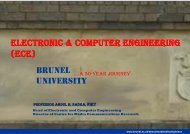DEliverable 2.3 - the School of Engineering and Design - Brunel ...
DEliverable 2.3 - the School of Engineering and Design - Brunel ...
DEliverable 2.3 - the School of Engineering and Design - Brunel ...
You also want an ePaper? Increase the reach of your titles
YUMPU automatically turns print PDFs into web optimized ePapers that Google loves.
ICT Project 3D VIVANT– Deliverable <strong>2.3</strong><br />
Contract no.:<br />
248420<br />
User Acceptance Validation Plan<br />
first one will be stereoscopic content generated from <strong>the</strong> 3D holoscopic content (through <strong>the</strong> 3D<br />
holoscopic s<strong>of</strong>tware plug-in tool that will be developed in M18 under <strong>the</strong> scope <strong>of</strong> Deliverable D3.9)<br />
that will be displayed on a commercial 2D monitor with users wearing special 3D glasses. The second<br />
one will be 3D holoscopic content that is displayed on three different types <strong>of</strong> displays.<br />
User acceptance tests will largely depend on <strong>the</strong> viewing conditions during <strong>the</strong> test. ITU-R<br />
Recommendation BT.500, clause 2.1.2, viewing conditions are considered “slightly more critical than<br />
<strong>the</strong> optimal home viewing conditions” <strong>and</strong> optimal conditions are described. This lighting<br />
environment is suggested for evaluating <strong>the</strong> “quality at <strong>the</strong> consumer side <strong>of</strong> <strong>the</strong> TV chain” <strong>and</strong> could<br />
be adopted as a basis for <strong>the</strong> tests envisaged in <strong>the</strong> project just like <strong>the</strong> Preferred Viewing Distance<br />
(PVD) recommended in ITU-R BT.500.<br />
It should be taken into account that <strong>the</strong> main purpose <strong>of</strong> <strong>the</strong> ITU-R BT.500 is to define a st<strong>and</strong>ard<br />
viewing environment in order to obtain comparable results with different assessment sessions.<br />
However, <strong>the</strong> definition <strong>of</strong> optimal, or preferred, viewing conditions for a 3D display is still an open<br />
issue. Consequently, for <strong>the</strong> tests to be carried out in <strong>the</strong> frame <strong>of</strong> <strong>the</strong> project, <strong>the</strong> viewing<br />
environment suggested in ITU-R BT.500 will be implemented, whereas <strong>the</strong> parameters related to <strong>the</strong><br />
display will be chosen so that <strong>the</strong> resulting viewing conditions will be felt optimal by <strong>the</strong> viewers.<br />
4.1.2 Hearing<br />
Spatial audio generation <strong>and</strong> playback will also be an integral part <strong>of</strong> <strong>the</strong> 3D VIVANT system. The<br />
main goal is to provide a consistent spatial audio experience accompanying <strong>the</strong> holoscopic video<br />
content. Thus, at least <strong>the</strong> same degrees <strong>of</strong> freedom as possible with <strong>the</strong> holoscopic display <strong>and</strong><br />
content should be provided to one or more end-users. The key objectives are to allow plausible<br />
localisation <strong>of</strong> objects in respect to <strong>the</strong> visual experience, perception <strong>of</strong> spatiality <strong>and</strong> depth, <strong>and</strong> an<br />
overall coherent immersive listening experience.<br />
For audio generation a new spherical surface microphone has been designed. Accordingly an<br />
interpolation algorithm has been developed, to simulate microphone positions on <strong>the</strong> spherical surface<br />
between <strong>the</strong> six existing microphones. This algorithm (<strong>and</strong> <strong>the</strong> spherical surface microphone itself)<br />
have to be assessed through listening tests to find out <strong>the</strong> quality level <strong>of</strong> sound with following<br />
criteria:<br />
• Sound colouration – A correct interpolation <strong>of</strong> microphone positions with as less as possible<br />
sound colouration in comparison to a real microphone at this position is very significant. This<br />
criterion will be tested with <strong>the</strong> MUSHRA (#2.4.1) method (without low anchor). Three<br />
variations <strong>of</strong> <strong>the</strong> developed algorithm <strong>and</strong> two known will be compared.<br />
• Quality <strong>of</strong> localisation – The spherical surface microphone can also be used for binaural hearing.<br />
Therefore <strong>the</strong> perceived localisation <strong>of</strong> a sound source has to match <strong>the</strong> real position as well as<br />
possible. To test <strong>the</strong> quality <strong>of</strong> localisation with <strong>the</strong> spherical surface microphone a listening test<br />
with pointing (#2.4.2) on a scale to indicate <strong>the</strong> perceived sound sources will be conducted. This<br />
test will also evaluate <strong>the</strong> quality <strong>of</strong> localisation using interpolated microphones with different<br />
algorithms. A dummy head Neumann KU-100 will also to be rated for comparing with <strong>the</strong><br />
spherical surface microphone <strong>and</strong> <strong>the</strong> interpolation algorithms.<br />
Both tests will be conducted with headphone listening <strong>and</strong> a head-tracker for dynamic tracking <strong>of</strong> <strong>the</strong><br />
(binaural) signal. The reference is an artificially created (computer simulated) spherical surface<br />
microphone with 360 microphones on <strong>the</strong> equatorial plane. Only expert listener will be consulted in<br />
case <strong>of</strong> <strong>the</strong> small differences between <strong>the</strong> stimuli. A training session preceding <strong>the</strong> listening test will<br />
familiarize <strong>the</strong> test persons with <strong>the</strong> rating procedure (especially for <strong>the</strong> pointing method) <strong>and</strong> <strong>the</strong><br />
possible artefacts or differences.<br />
The spatial audio playback system will also be tested using <strong>the</strong> following criteria:<br />
01.09.11 19
















